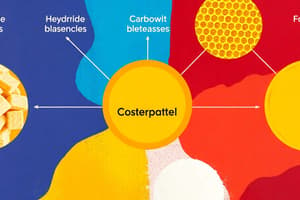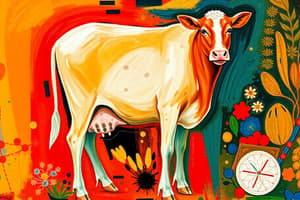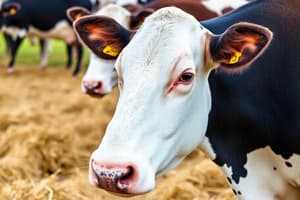Podcast
Questions and Answers
Which of the following best describes the primary role of carbohydrates in an animal's diet?
Which of the following best describes the primary role of carbohydrates in an animal's diet?
- Providing essential fatty acids
- Serving as a key energy source (correct)
- Supporting bone development
- Building block for muscle tissue
What structural characteristic is common to all carbohydrates?
What structural characteristic is common to all carbohydrates?
- They all contain a metallic element.
- They are all composed of nitrogen, phosphorus, and oxygen.
- They are all polymers of amino acids.
- They are all composed of carbon, hydrogen, and oxygen. (correct)
What proportion of an animal's diet should ideally consist of carbohydrates?
What proportion of an animal's diet should ideally consist of carbohydrates?
- 10-20%
- 70-80% (correct)
- 90-100%
- 30-40%
Why is it important for carbohydrates to be included in an animal's diet on a daily basis?
Why is it important for carbohydrates to be included in an animal's diet on a daily basis?
Which disaccharide is commonly referred to as 'table sugar'?
Which disaccharide is commonly referred to as 'table sugar'?
In the context of carbohydrate types, how do monosaccharides differ from polysaccharides?
In the context of carbohydrate types, how do monosaccharides differ from polysaccharides?
Which of the following is an example of a hexose, a six-carbon monosaccharide?
Which of the following is an example of a hexose, a six-carbon monosaccharide?
If an animal's body cannot convert fructose into glucose, what processes might be inhibited?
If an animal's body cannot convert fructose into glucose, what processes might be inhibited?
What is the primary consequence of lactose intolerance?
What is the primary consequence of lactose intolerance?
Which carbohydrate is a primary component of plant cell walls and is classified as a fiber?
Which carbohydrate is a primary component of plant cell walls and is classified as a fiber?
Which of the following disaccharides is composed of a glucose molecule bonded to a galactose molecule?
Which of the following disaccharides is composed of a glucose molecule bonded to a galactose molecule?
What is the main difference between soluble and insoluble fibers in an animal's diet?
What is the main difference between soluble and insoluble fibers in an animal's diet?
How does the digestion of carbohydrates differ between monogastric and ruminant animals?
How does the digestion of carbohydrates differ between monogastric and ruminant animals?
What is the role of amylase in carbohydrate digestion?
What is the role of amylase in carbohydrate digestion?
Where does carbohydrate digestion initially begin in monogastric animals?
Where does carbohydrate digestion initially begin in monogastric animals?
Why does carbohydrate digestion temporarily halt in the stomach of monogastric animals?
Why does carbohydrate digestion temporarily halt in the stomach of monogastric animals?
What two phases characterize intestinal carbohydrate digestion in monogastric animals?
What two phases characterize intestinal carbohydrate digestion in monogastric animals?
Following the action of pancreatic amylase, what types of molecules are produced for further digestion in the small intestine?
Following the action of pancreatic amylase, what types of molecules are produced for further digestion in the small intestine?
What is the final step in carbohydrate digestion performed by intestinal enzymes?
What is the final step in carbohydrate digestion performed by intestinal enzymes?
Which monosaccharides are the primary end products of carbohydrate digestion that are absorbed into the bloodstream?
Which monosaccharides are the primary end products of carbohydrate digestion that are absorbed into the bloodstream?
What are the two main mechanisms by which monosaccharides are absorbed from the intestinal lumen?
What are the two main mechanisms by which monosaccharides are absorbed from the intestinal lumen?
Which characteristic defines active transport in the absorption of glucose and galactose?
Which characteristic defines active transport in the absorption of glucose and galactose?
What is necessary for the active transport of glucose and galactose across the brush border membrane?
What is necessary for the active transport of glucose and galactose across the brush border membrane?
In active transport, how does sodium contribute to the movement of glucose into the cell?
In active transport, how does sodium contribute to the movement of glucose into the cell?
How is fructose transported across the brush border of the intestinal cells?
How is fructose transported across the brush border of the intestinal cells?
Following absorption, how are monosaccharides transported out of the mucosal cells into the bloodstream?
Following absorption, how are monosaccharides transported out of the mucosal cells into the bloodstream?
What is the primary role of rumen microbes in carbohydrate digestion for ruminant animals?
What is the primary role of rumen microbes in carbohydrate digestion for ruminant animals?
Rumen microbes break down complex carbohydrates into what simpler compounds?
Rumen microbes break down complex carbohydrates into what simpler compounds?
What are the three most abundant volatile fatty acids (VFAs) produced in the rumen?
What are the three most abundant volatile fatty acids (VFAs) produced in the rumen?
If a ruminant animal consumes more grains, which type of VFA would likely increase?
If a ruminant animal consumes more grains, which type of VFA would likely increase?
Which gases result from fermentation in the rumen?
Which gases result from fermentation in the rumen?
Which of these is a logical chain of events for ruminant carbohydrate digestion?
Which of these is a logical chain of events for ruminant carbohydrate digestion?
What role do cellulolytic bacteria play in the rumen, and which is their primary product?
What role do cellulolytic bacteria play in the rumen, and which is their primary product?
If a ruminant animal's diet suddenly shifts from roughage to grains, what is a potential consequence related to amylolytic bacteria?
If a ruminant animal's diet suddenly shifts from roughage to grains, what is a potential consequence related to amylolytic bacteria?
Which process typically occurs in the large intestine of animals concerning unabsorbed products of digestion?
Which process typically occurs in the large intestine of animals concerning unabsorbed products of digestion?
What is the function of the GLUT-2 transporter in carbohydrate metabolism?
What is the function of the GLUT-2 transporter in carbohydrate metabolism?
Where does the primary absorption of water, VFA, and the formation of feces occur?
Where does the primary absorption of water, VFA, and the formation of feces occur?
What is the main purpose of glycogen storage?
What is the main purpose of glycogen storage?
In ruminants, diets high in grains stimulate which bacteria?
In ruminants, diets high in grains stimulate which bacteria?
What is the primary reason carbohydrate digestion temporarily halts in the stomach of monogastric animals?
What is the primary reason carbohydrate digestion temporarily halts in the stomach of monogastric animals?
How does the digestion of carbohydrates in ruminant animals primarily differ from that in monogastric animals?
How does the digestion of carbohydrates in ruminant animals primarily differ from that in monogastric animals?
Why is the presence of sodium ions (Na+) crucial for the active transport of glucose and galactose across the intestinal brush border membrane?
Why is the presence of sodium ions (Na+) crucial for the active transport of glucose and galactose across the intestinal brush border membrane?
Which of the following best explains the role of GLUT-2 in carbohydrate transport after monosaccharides have been absorbed into mucosal cells?
Which of the following best explains the role of GLUT-2 in carbohydrate transport after monosaccharides have been absorbed into mucosal cells?
What is the primary fate of plant material after it is fermented into simple sugars in the rumen of ruminant animals?
What is the primary fate of plant material after it is fermented into simple sugars in the rumen of ruminant animals?
Flashcards
Carbohydrates
Carbohydrates
Organic compounds composed of carbon, hydrogen, and oxygen. Energy-providing nutrients.
Simple Carbohydrates
Simple Carbohydrates
Simple sugars, including monosaccharides (single sugars) and disaccharides (double sugars).
Monosaccharides
Monosaccharides
Single sugar molecules; includes glucose, fructose, and galactose. (C6H12O6)
Glucose
Glucose
Signup and view all the flashcards
Fructose
Fructose
Signup and view all the flashcards
Galactose
Galactose
Signup and view all the flashcards
Disaccharides
Disaccharides
Signup and view all the flashcards
Sucrose
Sucrose
Signup and view all the flashcards
Lactose
Lactose
Signup and view all the flashcards
Maltose
Maltose
Signup and view all the flashcards
Complex Carbohydrates
Complex Carbohydrates
Signup and view all the flashcards
Polysaccharides
Polysaccharides
Signup and view all the flashcards
Glycogen
Glycogen
Signup and view all the flashcards
Starch
Starch
Signup and view all the flashcards
Fiber
Fiber
Signup and view all the flashcards
Insoluble Fiber
Insoluble Fiber
Signup and view all the flashcards
Soluble Fiber
Soluble Fiber
Signup and view all the flashcards
NFE (Nitrogen-Free Extract)
NFE (Nitrogen-Free Extract)
Signup and view all the flashcards
Salivary α-amylase (ptyalin)
Salivary α-amylase (ptyalin)
Signup and view all the flashcards
Stomach's Role in Carbohydrate Digestion
Stomach's Role in Carbohydrate Digestion
Signup and view all the flashcards
Small Intestine in Digestion
Small Intestine in Digestion
Signup and view all the flashcards
Pancreatic α-amylase
Pancreatic α-amylase
Signup and view all the flashcards
Intestinal Enzymes
Intestinal Enzymes
Signup and view all the flashcards
Examples of Intestinal Enzymes
Examples of Intestinal Enzymes
Signup and view all the flashcards
End Products of Carbohydrate Digestion
End Products of Carbohydrate Digestion
Signup and view all the flashcards
Carbohydrate Absorption
Carbohydrate Absorption
Signup and view all the flashcards
Active Transport in Carbohydrate Absorption
Active Transport in Carbohydrate Absorption
Signup and view all the flashcards
Facilitative Transport in Carbohydrate Absorption
Facilitative Transport in Carbohydrate Absorption
Signup and view all the flashcards
Active Transport Mechanism
Active Transport Mechanism
Signup and view all the flashcards
Sodium Dependent Glucose Transporter (SGLT-1)
Sodium Dependent Glucose Transporter (SGLT-1)
Signup and view all the flashcards
Sodium Pump
Sodium Pump
Signup and view all the flashcards
Facilitative Transport Mechanism
Facilitative Transport Mechanism
Signup and view all the flashcards
Sodium Independent Transporter
Sodium Independent Transporter
Signup and view all the flashcards
Ruminant Diet and Carbohydrates
Ruminant Diet and Carbohydrates
Signup and view all the flashcards
Rumen Microbes
Rumen Microbes
Signup and view all the flashcards
Carbohydrate Digestion in Ruminants
Carbohydrate Digestion in Ruminants
Signup and view all the flashcards
Waste products of carbohydrate digestion in ruminants
Waste products of carbohydrate digestion in ruminants
Signup and view all the flashcards
VFAs (Volatile Fatty Acids
VFAs (Volatile Fatty Acids
Signup and view all the flashcards
Substrate fermented by Cellulolytic bacteria
Substrate fermented by Cellulolytic bacteria
Signup and view all the flashcards
Substrate fermented by Pectinolytic bacteria
Substrate fermented by Pectinolytic bacteria
Signup and view all the flashcards
Substrate fermented by Hemicellulolytic bacteria
Substrate fermented by Hemicellulolytic bacteria
Signup and view all the flashcards
Substrate fermented by Amyolytic bacteria
Substrate fermented by Amyolytic bacteria
Signup and view all the flashcards
VFAs produced by cellulolytic bacteria
VFAs produced by cellulolytic bacteria
Signup and view all the flashcards
Cause of lactic acidosis (rapidly decreases pH)
Cause of lactic acidosis (rapidly decreases pH)
Signup and view all the flashcards
Small Intestine Function
Small Intestine Function
Signup and view all the flashcards
Caecum & Large Intestine
Caecum & Large Intestine
Signup and view all the flashcards
Study Notes
Carbohydrates
- Carbohydrates have the formula (CH₂O)n.
- They consist of carbon, hydrogen and oxygen.
- They provide energy and compose 70-80% of an animal's diet.
- Carbohydrates have to be provided daily in an animal’s diet.
Carbohydrate Types
- Simple carbohydrates include Monosaccharides (single sugars) and Disaccharides (double sugars).
- Complex carbohydrates include Polysaccharides (many sugars).
Monosaccharides: Simple Carbohydrates
- Monosaccharides are hexoses (six-carbon sugars) or pentoses (five-carbon sugars).
- Glucose, fructose, galactose, and mannose all have the formula C6H12O6
Glucose
- Glucose is also known as dextrose or blood sugar.
- It is the body’s primary fuel.
- It is found in all disaccharides and polysaccharides.
- Only fructose and sucrose are sweeter.
- It occurs in nature combined with other compounds.
Fructose
- Fructose is also known as fruit sugar.
- It is found in fruit, honey, and syrup.
- Fructose converts to glucose in the body.
Galactose
- Galactose is part of lactose.
- It is found in milk.
- Galactose converts to glucose in the body.
- It is found in combination with lipid in nervous tissue.
Disaccharides: Simple Carbohydrates
- The disaccharides are sucrose, maltose and lactose.
Sucrose
- Sucrose is commonly known as table sugar.
- Glucose plus fructose make sucrose.
- Sucrose is refined from sugar beets and sugar cane.
Lactose
- Lactose is milk sugar.
- Glucose plus galactose make lactose.
- Lactose intolerance is caused by a missing digestive enzyme required to split lactose into monosaccharides for absorption.
Maltose
- Maltose is malt sugar.
- Glucose plus glucose make maltose.
- It is found in germinating seeds.
- Maltose is used in fermentation to produce malted beverages.
Polysaccharides: Complex Carbohydrates
- The polysaccharides are glycogen, starches, and fibers.
Glycogen
- Glycogen is a long chain of glucose found in animals.
- It is stored in the liver and muscles.
- Glycogen helps maintain blood glucose and is a source of quick energy, especially during exercise (lasting only 12 hours).
Starch
- Starch is a long chain of glucose found in plants.
- It can be found in cereal grains, legumes, and root vegetables.
Fiber
- Fiber is mostly indigestible carbohydrate, such as lignin.
- It is a component of plant cell walls.
- Fibers are classified according to solubility in water.
- Fiber is abundant in wholegrains, legumes, and fruits.
Types of Fiber
- Insoluble fibers are non-viscous, e.g., cellulose, lignin.
- Soluble fibers are viscous and fermentable, e.g., pectins.
Carbohydrate Digestion (Monogastrics)
- Nitrogen-free extract (NFE) refers to soluble carbohydrates like starches and sugars.
- Enzymatic digestion breaks down NFE into hexoses like glucose in monogastric animals.
- NFE breakdown occurs mostly in the small intestine.
Digestion in the Mouth
- Carbohydrate digestion starts in the mouth.
- Salivary glands secrete α-amylase (ptyalin) which initiates the hydrolysis of starch.
- Salivary α-amylase acts on dietary starch during mastication, randomly breaking α-(1 → 4) bonds and hydrolyzing starch into dextrins.
Digestion in the Stomach
- Carbohydrate digestion halts temporarily in the stomach.
- High acidity inactivates salivary α-amylase.
Digestion in the Intestine
- Further digestion of carbohydrates by pancreatic enzymes occurs in the small intestine.
- The two phases of intestinal digestion are due to pancreatic α-amylase and to intestinal enzymes: sucrase, maltase, lactase, isomaltase.
Role of Pancreatic α-Amylase
- Pancreatic α-amylase degrades dextrins further into a mixture of maltose, isomaltose, and α-limit dextrin.
- α-limit dextrins are small oligosaccharides containing 3 to 5 glucose units.
Role of Intestinal Enzymes
- A final phase of carbohydrate digestion occurs in the brush-border membrane.
- Maltase acts on Maltose to produce Glucose + Glucose.
- Isomaltase acts on Isomaltose to produce Glucose + Glucose.
- Sucrase acts on Sucrose to produce Glucose + Fructose.
- Lactase acts on Lactose to produce Glucose + Galactose.
- Dextrinase acts on a-Limit dextrin to produce Glucose + Maltose.
End Products of Carbohydrate Digestion
- Glucose, fructose, and galactose are the end products.
- They are readily absorbed through the intestinal mucosal cells into the bloodstream.
Absorption of Carbohydrates
- Carbohydrates are absorbed as monosaccharides from the intestinal lumen.
- Active transport goes against a concentration gradient, i.e., from low to high glucose concentration.
- Facilitative transport goes with a concentration gradient, i.e., from high to low concentration.
Active Transport
- Glucose and galactose are transported across the brush border membrane of mucosal cells via active transport.
- Active transport requires energy, a specific transport protein, and the presence of sodium ions.
Sodium Dependent Glucose Transporter (SGLT-1)
- A sodium-dependent glucose transporter (SGLT-1) binds glucose and Na+ at separate sites.
- It transports them through the plasma membrane of the intestinal cell.
Sodium Transport
- Na+ is transported down its concentration gradient from high to low concentration, while glucose is transported against its concentration gradient.
Active Transport Energy
- Free energy required for active transport is obtained from ATP hydrolysis linked to a sodium pump.
- The sodium pump expels Na+ from the cell in exchange for K+.
Facilitative Transport
- Fructose and mannose are transported across the brush border by a Na+-independent facilitative diffusion process (GLUT-5).
- Glucose and galactose can use this transport if the concentration gradient is favorable.
Carbohydrate Transport to the Liver
- The sodium-independent transporter, GLUT-2, facilitates the transport of sugars out of the mucosal cells.
- This allows sugars to enter the portal circulation for transport to the liver.
Carbohydrate Digestion (Ruminants)
- Ruminant diets contain cellulose, hemicellulose, and lignin.
- Enzymes secreted by rumen microbes break down complex carbohydrates.
- This results in VFAs and gases.
Carbohydrate Digestion in Ruminants
- It occurs through microbial fermentation in the rumen.
- Plant material ferments into simple sugars which microbes utilize and produce waste products.
- The waste products are gases, heat, and VFAs.
- Ratios of VFAs depend on the diet type consumed.
Composition of VFAs and Gases in the Rumen
- VFAs contain 60-70% acetic acid, 15-20% propionic acid, and 10-15% butyric acid.
- Gases in the rumen contain 76% carbon dioxide, 22% methane, and 2% hydrogen.
- Small amounts of oxygen and nitrogen are from ingested air.
- VFAs are absorbed directly from the rumen, reticulum, and abomasum.
Microbial Populations in the Rumen
- Cellulolytic: Ferment plant fibre (cellulose).
- Pectinolytic: Ferment plant fibre (pectins).
- Hemicellulolytic: Ferment plant fibre (hemi-cellulose).
- Amyolytic: Ferment starch.
- Ureolytic: Ferment urea.
- Proteolytic: Ferment proteins.
Cellulolytic Bacteria
- Cellulolytic bacteria produce cellulose to break down cellulose which is the primary substrate.
- They mainly produce acetate, but also some propionate and little butyrate.
- They prefer a pH of 6-7.
- They predominate in animals fed roughage diets.
Amylolytic Bacteria
- Amylolytic bacteria digest starches and sugars.
- They prefer a pH of 5-6.
- They mainly produce propionate, less butyrate, and sometimes lactate.
- They predominate in animals fed grain diets.
- A rapid change to a grain diet can cause lactic acidosis (rapidly decreases pH)
- Streptococcus bovis is an example of this type of bacteria.
Role of the Small Intestine
- The small intestine is responsible for the secretion of digestive enzymes.
- It allows digestive secretions from pancreas and liver.
- It enables further digestion of carbohydrates.
- It facilitates the absorption of H₂O, minerals, amino acids, and glucose.
Role of the Large Intestine
- The large intestine containing the Caecum enables bacterial population to ferment unabsorbed products of digestion.
- It enables absorption of H₂O and VFA and the formation of faeces.
Studying That Suits You
Use AI to generate personalized quizzes and flashcards to suit your learning preferences.




